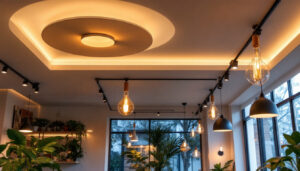

In the rapidly evolving world of lighting solutions, solar-powered lights have emerged as a game-changer for both residential and commercial applications. As a lighting contractor, understanding the nuances of solar lighting technology can enhance your service offerings and provide your clients with sustainable options. This handbook delves into the essential aspects of solar-powered lights, from their components to installation practices, ensuring that you are well-equipped to meet the growing demand for eco-friendly lighting solutions.
Solar-powered lights operate using photovoltaic cells that convert sunlight into electricity. This technology has advanced significantly over the years, making solar lights more efficient and reliable. Understanding how these systems work is crucial for lighting contractors looking to integrate solar solutions into their projects. The increasing demand for sustainable energy sources has propelled innovations in solar technology, leading to enhanced performance and longer lifespans for solar-powered lighting solutions. As a result, contractors are now presented with a wealth of options that not only reduce energy costs but also contribute to environmentally friendly practices.
Solar lights consist of several key components: solar panels, batteries, LED bulbs, and controllers. The solar panels capture sunlight and convert it into electrical energy, which is stored in batteries for later use. LED bulbs provide illumination, while controllers manage the power flow, ensuring that lights operate efficiently. The integration of smart technology in controllers has further improved the functionality of solar lights, allowing for features such as motion sensors and timers that optimize energy consumption based on environmental conditions.
Each component plays a vital role in the overall performance of solar lights. For instance, the quality of the solar panel directly affects the energy conversion rate, while the battery capacity determines how long the lights can operate after sunset. Additionally, advancements in battery technology, such as lithium-ion batteries, have significantly increased storage efficiency and reduced charging times. Understanding these components will enable contractors to select the best products for their projects, ensuring that clients receive reliable and effective solar lighting solutions that meet their specific needs.
There are various types of solar-powered lights available on the market, each designed for specific applications. Pathway lights, floodlights, and decorative lights serve different purposes, from enhancing safety to adding aesthetic appeal. Understanding the distinct features and functions of each type will help contractors recommend the right solutions to their clients. Moreover, the versatility of solar lights allows them to be used in a wide range of settings, from residential gardens to commercial properties, making them an attractive option for diverse projects.
For example, pathway lights are typically low to the ground and provide illumination for walkways, while floodlights are designed for broader coverage and security. Decorative lights can enhance outdoor spaces, creating ambiance while still being functional. Additionally, solar string lights have gained popularity for their ability to transform outdoor areas into inviting spaces for gatherings and events. By familiarizing themselves with these options, contractors can tailor their offerings to meet diverse client needs, ensuring that each installation not only serves a practical purpose but also enhances the overall aesthetic of the environment.
Solar-powered lights offer numerous advantages that make them an attractive option for both contractors and clients. These benefits range from cost savings to environmental impact, making solar lights a compelling choice for modern lighting solutions.
One of the most significant advantages of solar lighting is the reduction in energy costs. Since solar lights rely on sunlight, they do not contribute to electricity bills, providing long-term savings for homeowners and businesses alike. Additionally, the initial investment in solar lighting can often be recouped through these savings over time.
Moreover, solar lights typically require minimal maintenance compared to traditional lighting systems. With no wiring to install and fewer moving parts, the ongoing costs associated with repairs and replacements are significantly lower. This cost efficiency makes solar lights an appealing option for contractors looking to provide value to their clients. Furthermore, many solar lighting products come with warranties that can extend for several years, offering peace of mind and further enhancing their cost-effectiveness. As technology advances, the prices of solar lighting solutions continue to decrease, making them even more accessible to a wider audience.
Solar lighting solutions contribute to a more sustainable future by reducing carbon footprints. By harnessing renewable energy, solar lights help decrease reliance on fossil fuels, thus mitigating the effects of climate change. This aspect is increasingly important to clients who prioritize eco-friendly practices in their purchasing decisions.
Furthermore, solar lights do not emit harmful pollutants, making them a safer choice for both indoor and outdoor environments. By offering solar lighting options, contractors can align their services with the growing trend towards sustainability and environmental responsibility. In addition to reducing greenhouse gas emissions, solar lighting can also promote biodiversity by minimizing light pollution, which can disrupt local wildlife. This consideration is particularly vital in residential areas near natural habitats, where preserving the local ecosystem is essential. As communities become more aware of their environmental impact, the demand for solar lighting solutions is likely to increase, making it a forward-thinking choice for contractors and clients alike.
Effective installation is crucial for the optimal performance of solar-powered lights. Lighting contractors must be familiar with best practices to ensure that these systems function efficiently and meet client expectations.
Before installation, conducting a thorough site assessment is essential. This involves evaluating the amount of sunlight the location receives throughout the day, as well as identifying potential obstructions such as trees or buildings that may cast shadows on the solar panels. Proper site assessment ensures that the solar lights will receive adequate sunlight for optimal performance.
Additionally, understanding the specific lighting needs of the area will help contractors determine the appropriate type and number of solar lights required. For instance, a pathway may need more lights spaced closely together, while a larger area may benefit from fewer, more powerful floodlights.
Once the site assessment is complete, proper placement of the solar lights is critical. Solar panels should be positioned to maximize sun exposure, ideally facing south in the northern hemisphere. This placement allows for maximum energy absorption during the day, ensuring that the lights operate effectively at night.
During installation, it is also important to secure the lights firmly to prevent movement from wind or other environmental factors. Using durable materials and following manufacturer guidelines will help ensure a successful installation that meets client expectations.
While solar lights require minimal maintenance, periodic checks are essential to ensure their longevity and performance. Contractors should educate clients on basic maintenance practices to keep their solar lighting systems functioning optimally.
One of the simplest yet most effective maintenance tasks is cleaning the solar panels. Dust, dirt, and debris can accumulate on the surface, reducing their efficiency. A gentle wash with soap and water can help maintain optimal performance. Contractors can recommend a cleaning schedule based on local environmental conditions, such as frequency of dust storms or heavy rainfall.
Additionally, inspecting the LED bulbs for any signs of wear or damage is important. Replacing bulbs as needed will ensure that the lights continue to function properly and provide adequate illumination.
Despite their reliability, solar lights can encounter issues from time to time. Contractors should be prepared to troubleshoot common problems, such as dim lighting or complete failure to turn on. Often, these issues can be traced back to insufficient sunlight exposure, a dead battery, or faulty connections.
Educating clients on how to identify these issues can empower them to address minor problems independently. For example, if the lights are not turning on, checking the battery and ensuring the solar panel is clean and unobstructed can often resolve the issue without requiring professional intervention.
The solar lighting industry is continuously evolving, with new technologies and trends emerging regularly. Staying informed about these developments can help contractors remain competitive and offer cutting-edge solutions to their clients.
One of the most exciting trends in solar lighting is the integration of smart technology. Smart solar lights can be controlled remotely via mobile applications, allowing users to adjust brightness levels, set timers, and even monitor energy consumption. This added convenience appeals to tech-savvy clients who seek modern solutions.
Additionally, smart solar lights can be equipped with motion sensors, enhancing security and energy efficiency. By turning on only when movement is detected, these lights conserve energy while providing safety and illumination as needed.
Advancements in battery technology are also shaping the future of solar lighting. Newer battery types, such as lithium-ion batteries, offer higher energy storage capacities and longer lifespans compared to traditional lead-acid batteries. This improvement means that solar lights can operate for extended periods, even on cloudy days or during the winter months when sunlight is limited.
Contractors should keep an eye on these advancements, as they can significantly enhance the performance and reliability of solar lighting systems. Offering clients the latest technology can set contractors apart in a competitive market.
As the demand for sustainable lighting solutions continues to rise, solar-powered lights present an excellent opportunity for lighting contractors to expand their service offerings. By understanding the technology, benefits, installation practices, and future trends associated with solar lighting, contractors can position themselves as experts in this growing field.
Investing in knowledge and staying informed about advancements in solar technology will not only enhance the services provided but also contribute to a more sustainable future. Embracing solar-powered lights is not just a trend; it is a step towards a greener, more efficient world.
Ready to harness the power of solar lighting and elevate your lighting projects? At LumenWholesale, we provide lighting contractors like you with the highest quality, spec-grade solar-powered lights at unbeatable wholesale prices. Say goodbye to middleman markups and hello to superior products that meet the strictest industry standards. With our hassle-free bulk buying and free shipping, you can trust that you’re getting premium lighting solutions at the best value — no hidden fees, no compromises. Take the next step towards a greener, more efficient future and experience Wholesale Lighting at the Best Value with LumenWholesale today.

Discover expert insights from lighting contractors on choosing the brightest LED light bulbs for your projects.

Discover the top five reasons why lighting contractors should prioritize different types of fluorescent lights.

Discover the essentials of 10Ft power cord linkable shop lights and their compliance standards.

Discover how Industrial Lighting Products in Sanford are transforming projects with real-world success stories.
Get notified when NEW deals are released.
Optimize your budget with wholesale discounts.
Only top-quality, specification-grade lighting products.
No additional costs at checkout - what you see is what you pay.
We understand the unique needs of contractors.